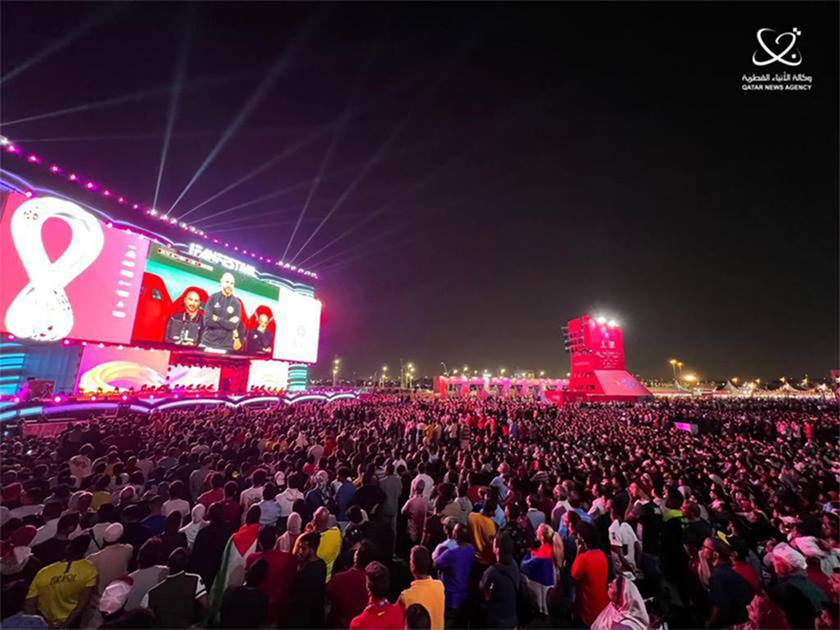FIFA World Cup Qatar 2022 1-Year Anniversary: Fan Zones Were Their Own Spectacle

Doha, November 21 (QNA) - FIFA World Cup Qatar 2022 fan zones deeply resonated with the tournament's audience, who experienced captivating moments during the event's first occurrence in the Arab world and the Middle East.
Over the course of 29 days, these areas showcased remarkable numbers, serving as exceptional evidence of the 22nd edition's monumental successes. Qatar, with its proximate venues, presented a spectacular display across fan zones that witnessed a record attendance of fans from various participating nations. The daily attendance at the diverse events reached approximately 530,000 individuals. These events were held at various venues, including the FIFA Fan Zone in Al Bidda Park, areas surrounding stadiums, Doha's Corniche, and fan zones spread throughout the country.
The FIFA Fan Zone garnered immense attention, drawing over 1.8 million enthusiasts who enjoyed live match broadcasts and a myriad of entertainment programs. FIFA clocked around 170 hours of live broadcast and 100 hours of live music from global and regional stars within a space spanning five thousand square meters. All eyes were on Souq Waqif, a vibrant area that welcomed the World Cup fans amid a distinctive ambiance, blending heritage with modernity in every detail.
Souq Waqif, situated in the heart of Doha, with its old and small buildings, transformed into a celebratory hub for the participating teams' fans. They infused the atmosphere with their fervor, notably the Argentine supporters, who played captivating musical compositions, chanting songs like "Muchachos" to the beat of drums, creating an enchantment that will remain etched in everyone's memories.
The unique celebration by Argentine fans, marking their presence at stadiums and zones, earned them the FIFA Fan Award. Thousands of Argentinians left their mark across Doha during the tournament, boosting the morale of Lionel Messi's teammates and providing them with immense energy to claim the coveted cup after a prolonged absence from championship platforms.
Various fan zones saw the fervent celebrations of other national teams' supporters, particularly the Mexican fans, who exhibited their flags and famous Mexican sombreros while singing traditional songs and chants.
Qatar welcomed over 1.4 million visitors from around the globe. It was natural that match attendance rates during the tournament reached their peak, totaling 3,404,252 spectators. The tournament's final round of the group stage witnessed 2,457,059 attendees, while the final match at Lusail Stadium had a record-breaking attendance, hosting its full capacity of 88,966 spectators. This match marked the third event with the same attendance figures. The average attendance per match was 53,000 spectators, surpassing a total occupancy rate of 96%.
The spectator turnout during the FIFA World Cup Qatar 2022, since the quarter-finals, exceeded the figures from the 2018 Russia World Cup. Qatar's World Cup witnessed a presence of 3,113,889 spectators across 60 matches, compared to 64 matches with 3,031,768 spectators in Russia.
Qatar's World Cup surpassed the spectator attendance of the 1998 France World Cup, which had 2,785,100 attendees, and also exceeded the 2002 South Korea-Japan World Cup with 2,705,197 spectators in attendance.
The FIFA World Cup Qatar 2022 ranked third in terms of spectator attendance in the tournament's history, with 3,404,252 fans. The highest attendance record remains with the 1994 America World Cup, hosting 3,587,538 fans, followed by the 2014 Brazil World Cup in second place with 3,429,873 attendees. The 2006 Germany World Cup ranked fourth with 3,359,439 spectators.
The vast audience that followed the 2022 FIFA World Cup in Qatar from various fan zones created an atmosphere resonating with diverse interactions, celebrating goals, and embracing the different fan cultures. The global audiences exemplified remarkable instances of peaceful coexistence in Doha.
Despite the unprecedented and substantial movement from residences to fan zones and stadiums, Qatar provided a secure means of transportation through the Doha Metro. It acted as a hub for interaction among people, transforming metro spaces into mini event areas that vividly portrayed the principle of cultural convergence through football.
The substantial number of spectators utilizing the Doha Metro and trams, totaling 18.2 million passengers, to reach stadiums and fan zones, experienced exceptional service provided by 20,000 volunteers.
The organization's directives and volunteer services proved instrumental in enabling attendees to break previous attendance records by continually visiting fan zones. Among the spectators attending the event, diverse talents in painting and artistic expressions showcased a cultural aspect enriched with artistry, contributing to a multifaceted World Cup.
The FIFA World Cup Qatar 2022 was characterized by having the closest proximity of stadiums since the inaugural 1930 World Cup in Uruguay. The eight stadiums, all within an hour's distance from central Doha, provided fans the opportunity to attend more than one match per day, a unique experience not seen in previous editions.
The 2022 World Cup in Qatar marks the final edition featuring 32 teams before FIFA increases the participating teams to 48 starting from the subsequent edition in the United States, Canada, and Mexico in 2026.
(QNA)





